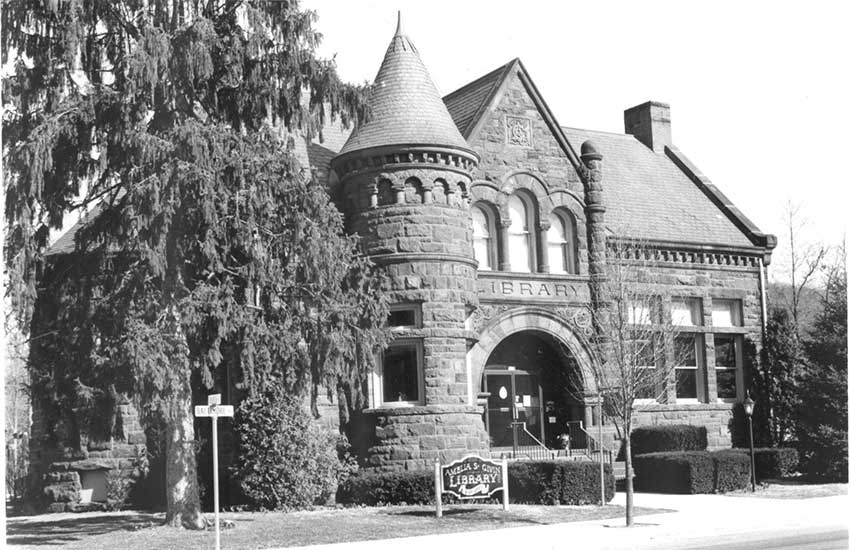Amelia Steele Givin was born on October 31, 1845. She was the only daughter of Robert and Sara (Gibson) Givin; she had four brothers who predeceased her. Her father and his brother, Samuel, were the founders of a paper mill in Mt. Holly Springs, and the Givin family lived nearby until 1865 when their home burned to the ground. After the fire, Mr. Givin paid for the construction of a colonial revival building just west of First Presbyterian Church on West High Street in Carlisle. The family lived on the second and third floors; the Farmers Trust Bank occupied the ground level of the building at that time; a succession of banks have occupied the site over the decades.
When her father, Robert, died on February 9, 1879, Amelia took on his responsibilities at the paper company. At the end of the nineteenth century, it was very unusual for an unmarried woman to be in a position of authority in a business, but she took her role seriously. When her mother died in 1887, she inherited a fortune from her late father's estate. She traveled widely through the years, and she also supported a number of charitable groups during her lifetime.1
The most visible example of Amelia Givin's philanthropy is the library in Mt. Holly Springs that bears her name. She provided the funds to build the library in 1889, and it was dedicated on January 2, 1890, making it the oldest public library in Cumberland County. She also endowed a perpetual trust for the library. Architecturally, the library is in the Richardson Romanesque style—named for famed architect Henry Hobson Richardson. The distinctive exterior of brick and brownstone, looks remarkably grand in Mt. Holly Springs. The library was very modern for its time; it boasted conveniences like electric lights and hot water heating. The interior rooms have marble and tile fireplaces beneath high ceilings of solid Indiana oak, and there are intricately carved wooden screens of interlaced polished wood separating the reading rooms from the foyer. These unusual screens, called Moorish fretwork, are truly magnificent. Cynthia Thompson, the library’s director in 2000, stated that the library was “for the mill workers and their families. Miss Givin was ahead of her time in wanting education and information available for everyone, no matter how much money you had or your status in life."2 The library was added to the National Register of Historic Places in 2004.
As part of a socially and economically important family in Cumberland County, events in the lives of members of the Givin family were often reported in local newspapers. These articles provide insights regarding the family and about contemporary life in the county. On June 2, 1892, Amelia Givin married Walter Beall, of Cumberland, MAryland, and the newspaper account of her wedding informs readers that she was “the direct lineal descendant of the heroic 'fighting Parson Steele' who, more than one hundred and twenty-five years ago, made his church a refuge from the Indians and preached with his musket beside him. With such blood in her veins Miss Givin's public spirit and wide beneficence are no surprise.” That day's paper also provides the information that a special car of the Cumberland Valley Railroad stopped at her home to take the bridal couple east so that they could travel to Europe for their honeymoon.3
Amelia Givin Beall lived 10 years after her husband died in 1905. The couple had no children. Local stories tell that during the decade of her widowhood, she frequently went to the library and sent the librarian for a ride in her own carriage while she worked in the librarian's place. The library is the most visible evidence of Amelia Givin Beall's gifts to the communities where she lived, but she supported many other charities including Carlisle Hospital, Second Presbyterian Church in Carlisle and the Female Benevolent Society of Carlisle. When she died on October 5, 1915, her estate was appraised at $200,000. Mrs. Thompson said, "She spent it, gave it away. She traveled all over the world for 20 years. The library probably cost about a half million dollars (to build)." In addition to the charities already mentioned, Mrs. Beall's will left provisions for her maid, cook and coachman, many friends and distant relatives.4
Amelia Steele Givin Beall, her husband, her parents, and other family members are buried at Carlisle's Ashland Cemetery.



